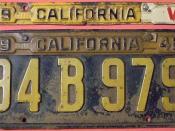"The Crisis of the Union"� The crisis of the union was a direct result of each and every theme present in the nation between 1810 and 1860- nationalism, development of democracy, sectionalism, the reform movement, manifest destiny, economic expansion, slavery, and the conflict between state and federal sovereignty. It is composed of all events leading to the Civil War. There are three major categories to consider when studying the crisis""slavery in the territories, the rise of the Republican Party, and the growing sectional crisis""all ultimately leading to the secession of the Deep South and the beginning of the American Civil War.
Expansion into the West brought controversy between the northern and southern states with regard to the expansion of slavery. If western territories were allowed to be settled as slave states, it would have been very difficult for people from the north to compete for work, as black slaves were the cheapest labor in existence.
The Wilmot Proviso of 1846 was a proposed amendment to a bill that provided an appropriation of $2 million for President James K. Polk to negotiate a territorial settlement with Mexico during the Mexican War. The amendment stated that none of the territory acquired in the war should be open to slavery. The bill was later changed to an appropriation of $3 million and was passed, but without the amendment. The Proviso created bitterness between the North and South and gave a glimpse of the conflict over the extension of slavery.
Popular Sovereignty, first proposed by Vice President George Dallas in 1847, proposed that the status of slavery in the territories be determined by the settlers themselves. It won wide support to begin with due to its ability to help avoid sectional conflict over the slavery issue. However, proponents of the doctrine disagreed on which...


![[California delegates cheering on stagecoach at the 1912 Republican National Convention held at the Chicago Coliseum, Chicago, Illinois, June 18-22, 1912] (LOC)](https://s.writework.com/uploads/9/94858/california-delegates-cheering-stagecoach-1912-republican-na-thumb.jpg)